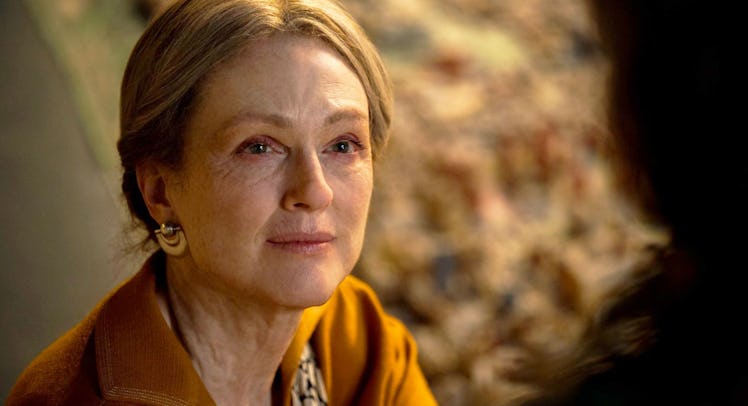Review: “Wonderstruck” Is Visually Dazzling, but Ultimately Disappointing
Todd Haynes' adaptation of Brian Selznick's young adult novel is well-intentioned and gorgeously rendered, but overstuffed and underwhelming.

There’s a moment very early on in Wonderstruck, the new film by Todd Haynes (Carol, I’m Not There), in which 12-year-old protagonist Ben (Oakes Fegley) encounters a tired Oscar Wilde quote: “We are all in the gutter, but some of us are looking at the stars.” The film never returns to the quote, nor does it explain why the quote, however poignant and relevant, was significant in the first place. It’s a decent example of the overstuffed plot plaguing the rest of the movie.
Here’s a theory: Wonderstruck wants to be a movie introduced by an Oscar Wilde quote. It also wants to be a meditation on disability and love and separation and self-identity. And while certainly well-intentioned and gorgeous to look at, the film’s reach exceeds its grasp.
Based on the bestselling young adult novel by Brian Selznick, who also wrote The Invention of Hugo Cabaret as well as the script for this film, Wonderstruck cuts between the stories of Ben, from 1977 Minnesota, and Rose, from 1927 New Jersey, both children who run away to New York City. Ben is reeling from the recent death of his mother and having to move into his aunt’s house. Meanwhile, Rose yearns to be independent from her oppressive father and to be with her mother, silent film star Lillian Mayhew (Julianne Moore). The two are also both deaf, with the difference being that Rose (who is portrayed by the young actress Millicent Simmonds, who is actually deaf) has lived with the disability most of her life. Ben, on the other hand, has only recently lost his hearing as the result of a whimsical accident involving lightning traveling down a landline, through a phone, and into his ear during a thunderstorm.
Haynes deftly switches between the two time periods, and both eras are rendered with such diligence and adoration for New York that the film looks absolutely stunning. Haynes has always had a knack for place, and Wonderstruck, much like 2015’s Carol and his other work, transports without feeling kitschy or overt. He captures Rose’s story as a silent film, like the ones she goes to watch her mother star in, presented in black and white with no dialogue, just ASL. His choices turn what could’ve been a gimmick into a meaningful exploration of the deaf experience. They do not, however, make the plot particularly gripping.
Millicent Simmonds, who plays Rose, deserves heaps of praise for her role. Simmonds is herself deaf and, weird as it sounds, this shows, not just in the understanding that she brings to the character but also in the immense amount of emotive expression she wields. Simmonds’ demeanor, the intimate details of the way she moves her eyes or mouth, is fantastic to watch. Here’s hoping that she has a long career ahead of her, not only for the sake of increased deaf representation, but because she’s got game. She just needs a less cluttered stage.
Unfortunately, the film’s other stars, Oakes Fegley and Jaden Michael, who plays Jamie, a young New Yorker Ben befriends after he runs away, struggle. Casting child actors is hard, but the Wonderstruck boys bend under the weight.
Ben and Jaime’s quest to find Ben’s father drives most of the plot. At first, the investigation centers on the American Museum of Natural History, shot with a sense of delight akin to a child’s first impressions of the exhibits. The museum is a star on its own, used as a refuge in both time periods. Ben and Rose each feel at home there amongst the dioramas and dinosaurs, and Haynes uses their shared sense of wonder 50 years apart to most closely connect the two characters before they meet in person. Wonderstruck is most entertaining when focused on the museum, particularly the antiquated 1927 version; the film’s plot quickly becomes contrived when its main characters leave.
A series of rushed coincidences lead Ben and Rose to meet in person in the present day, but the characters feel awkwardly forced together by the plot. The payoff of the inevitable encounter isn’t as satisfying as Wonderstruck wants it to seem, largely because the film tries to manufacture emotional moments rather than let them affect audiences organically. The climax involves a beautifully-animated stop-motion sequence and an incredible scale model of New York City, but, while this moment is visually sumptuous, it distracts from the lack of substance. No matter how enjoyable the scene is to watch, it hasn’t earned the emotion it wants to convey.
Throughout all this, Ben’s deafness persists. How will this new disability shape his life? What lessons can he learn from Rose, who’s also dealt with the challenges of her own deafness? Is Ben even that upset he can no longer hear? None of these questions get addressed. Given its 118-minute run-time, it’s not as though Wonderstruck lacked opportunity. Instead of exploring these mature topics, it seems to favor visual distraction, which is a missed chance even if that visual distraction is gorgeous to watch. The film itself feels less deaf than numb to its characters.
Wonderstruck is passably enjoyable. It may even be a contender for best cinematography, as it’s rendered so beautifully. But with Haynes at the helm and Selznick’s source material, there’s undoubtedly a better movie — and far more wonder — hiding somewhere within.